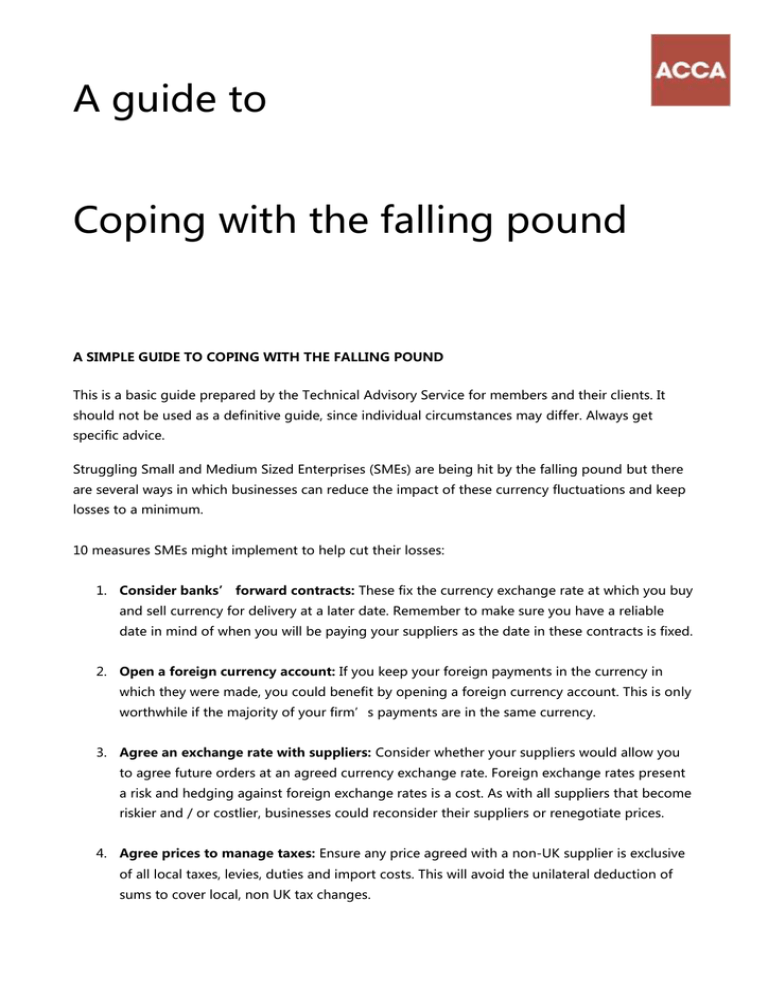ACCA Guide to... coping with the falling pound
advertisement

A guide to Coping with the falling pound A SIMPLE GUIDE TO COPING WITH THE FALLING POUND This is a basic guide prepared by the Technical Advisory Service for members and their clients. It should not be used as a definitive guide, since individual circumstances may differ. Always get specific advice. Struggling Small and Medium Sized Enterprises (SMEs) are being hit by the falling pound but there are several ways in which businesses can reduce the impact of these currency fluctuations and keep losses to a minimum. 10 measures SMEs might implement to help cut their losses: 1. Consider banks’ forward contracts: These fix the currency exchange rate at which you buy and sell currency for delivery at a later date. Remember to make sure you have a reliable date in mind of when you will be paying your suppliers as the date in these contracts is fixed. 2. Open a foreign currency account: If you keep your foreign payments in the currency in which they were made, you could benefit by opening a foreign currency account. This is only worthwhile if the majority of your firm’s payments are in the same currency. 3. Agree an exchange rate with suppliers: Consider whether your suppliers would allow you to agree future orders at an agreed currency exchange rate. Foreign exchange rates present a risk and hedging against foreign exchange rates is a cost. As with all suppliers that become riskier and / or costlier, businesses could reconsider their suppliers or renegotiate prices. 4. Agree prices to manage taxes: Ensure any price agreed with a non-UK supplier is exclusive of all local taxes, levies, duties and import costs. This will avoid the unilateral deduction of sums to cover local, non UK tax changes. 5. Consider negotiating prices: Suggest a mechanism for renegotiating the price where foreign exchange losses move outside a specified level of tolerance. This will depend on commercial circumstances and is unlikely to be acceptable with Euro denominated contracts. It is possible to achieve in jurisdictions with so-called "softer" currencies, such as Roubles, for example. 6. Match the currency: Match the currency of income to that of expenditure wherever this is possible and practical to eliminate foreign exchange risks. 7. Check transaction costs: Do be clear about the transaction costs associated with keeping funds in a local currency. In some jurisdictions these can be considerable. 8. Seek purrency protection: More flexible currency protection products also exist which give you protection against adverse exchange rate fluctuations but still allow you to take advantage if the exchange rates go in your favour. These products are expensive, however. 9. Stress test your costs: Businesses need to take stock of their costs and liabilities in foreign currencies and proactively ‘stress test’ their exposure against worst-case scenarios. This is simpler than it sounds - for example, businesses need to ask the question: “if the pound should fall to parity with the Euro, where does that leave us?” 10. Build in contingencies for potential losses: When establishing your price, build in a contingency for possible foreign exchange losses. Evaluating the level of contingency can be based on discussion with the foreign exchange department of your bank. They should be able to tell you what the forward exchange rate is estimated to be over the next 12 months. Of course, this simply reflects the perception of the money market as at stands on that day and should not be relied on as a certainty. COURTESY OF ACCA LEGAL NOTICE This Guide is an example only. It may not address all of the issues for each specific client. You should undertake additional research into any client matters not dealt with in the examples and amend your advice accordingly. While every care has been taken in the preparation of this Guide, neither the writer nor ACCA accept any responsibility for any loss occasioned by reliance on the Guide.






